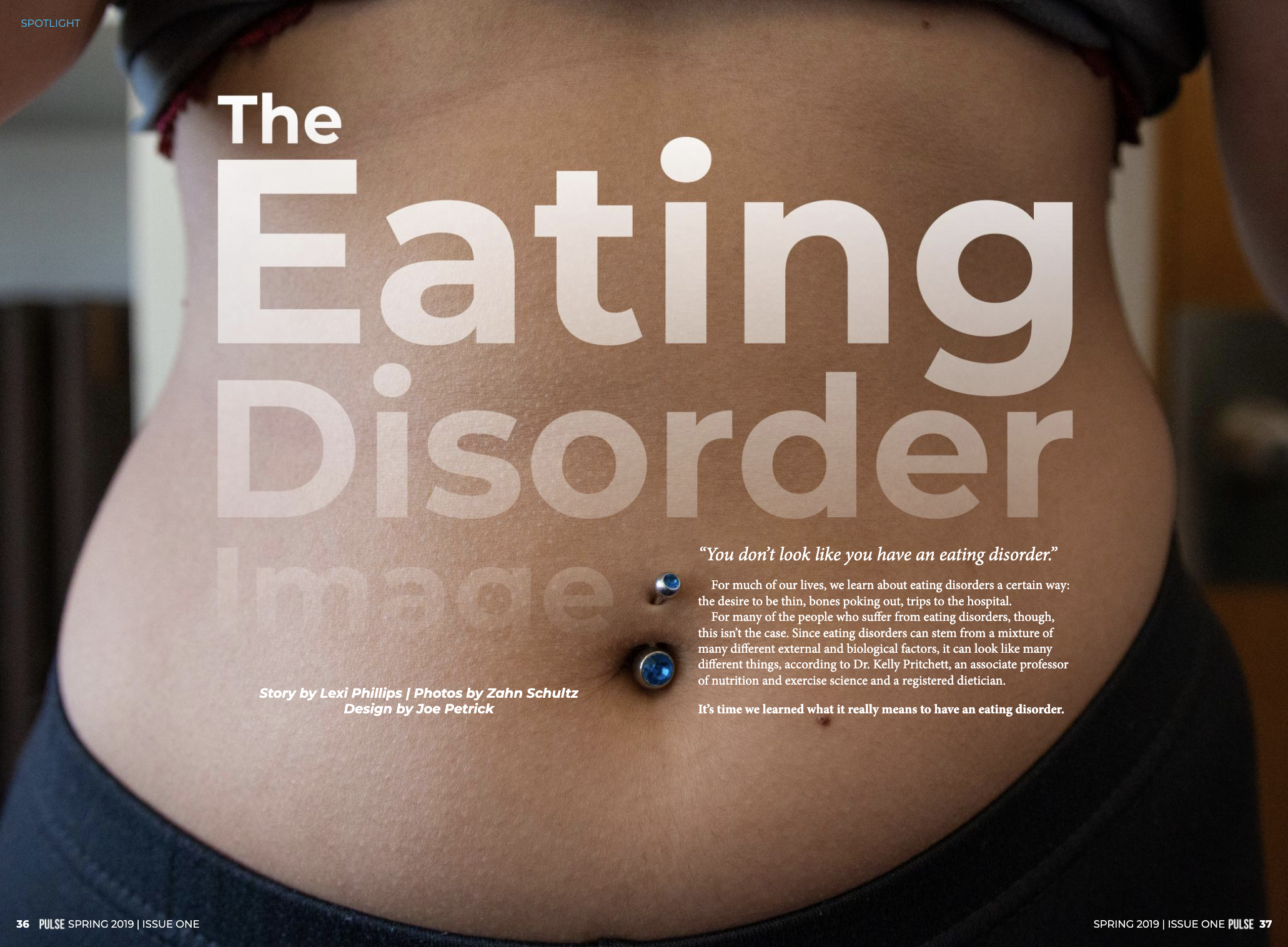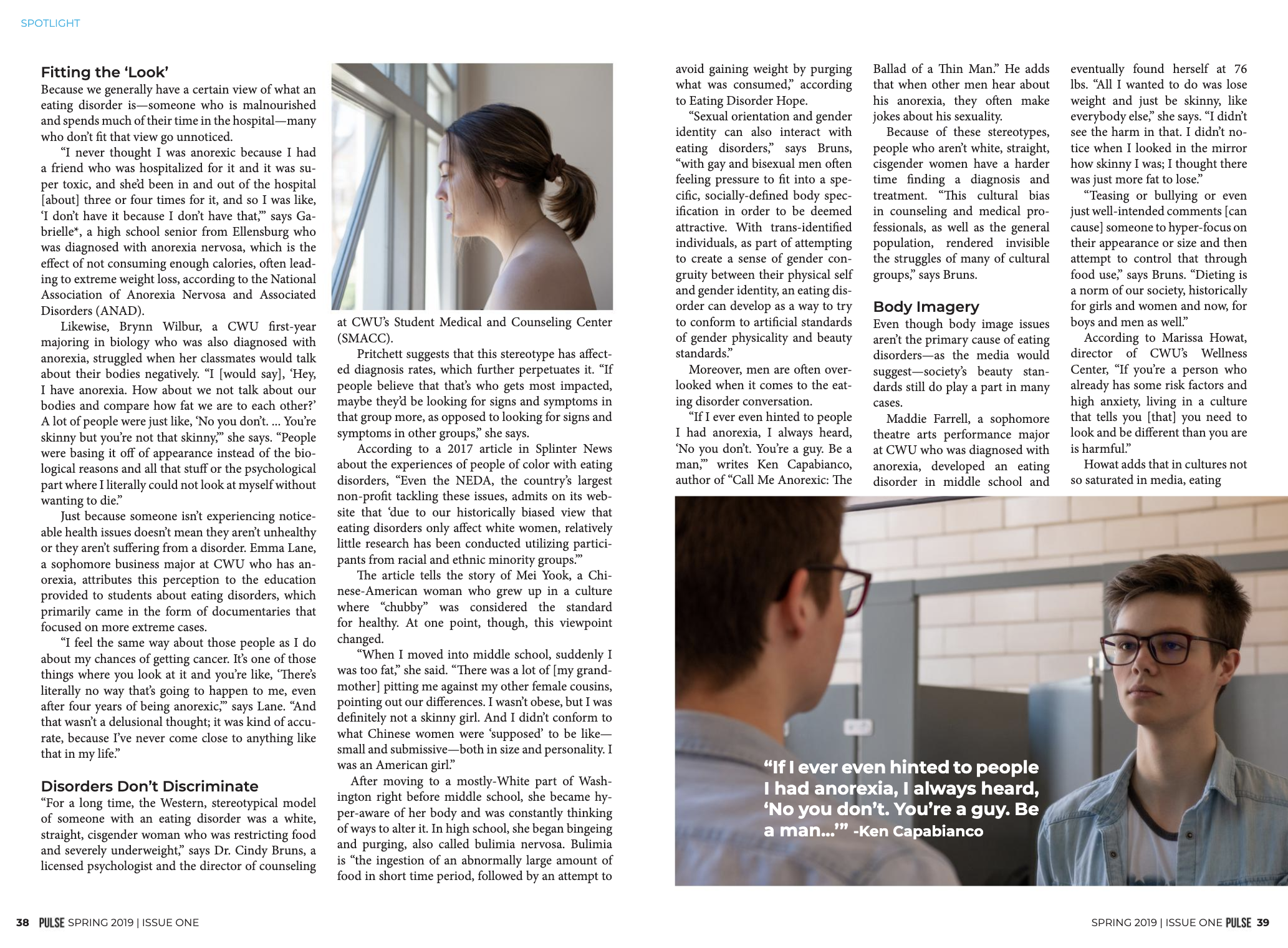The Eating Disorder Image
Story by Lexi Phillips | Photos by Zahn Schultz
You don't look like you have an eating disorder
For much of our lives, we learn about eating disorders a certain way: the desire to be thin, bones poking out, trips to the hospital.
For many of the people who suffer from eating disorders, though, this isn’t the case. Since eating disorders can stem from a mixture of many different external and biological factors, it can look like many different things, according to Dr. Kelly Pritchett, an associate professor of nutrition and exercise science and a registered dietician.
It's time we learned what it really means to have an eating disorder.
Fitting the ‘Look’
Because we generally have a certain view of what an eating disorder is—someone who is malnourished and spends much of their time in the hospital—many who don’t fit that view go unnoticed.
“I never thought I was anorexic because I had a friend who was hospitalized for it and it was super toxic, and she’d been in and out of the hospital [about] three or four times for it, and so I was like, ‘I don’t have it because I don’t have that,’” says Gabrielle*, a high school senior from Ellensburg who was diagnosed with anorexia nervosa, which is the effect of not consuming enough calories, often leading to extreme weight loss, according to the National Association of Anorexia Nervosa and Associated Disorders (ANAD).
Likewise, Brynn Wilbur, a CWU first-year majoring in biology who was also diagnosed with anorexia, struggled when her classmates would talk about their bodies negatively. “I [would say], 'Hey, I have anorexia. How about we not talk about our bodies and compare how fat we are to each other?' A lot of people were just like, 'No you don't. ...
You're skinny but you're not that skinny,”
she says. “People were basing it off of appearance instead of the biological reasons and all that stuff or the psychological part where I literally could not look at myself without wanting to die.”
Just because someone isn’t experiencing noticeable health issues doesn’t mean they aren’t unhealthy or they aren’t suffering from a disorder. Emma Lane, a sophomore business major at CWU who has anorexia, attributes this perception to the education provided to students about eating disorders, which primarily came in the form of documentaries that focused on more extreme cases.
“I feel the same way about those people as I do about my chances of getting cancer. It's one of those things where you look at it and you’re like, ‘There's literally no way that's going to happen to me, even after four years of being anorexic,’” says Lane. “And that wasn't a delusional thought; it was kind of accurate, because I've never come close to anything like that in my life.”
Disorders Don’t Discriminate
“For a long time, the Western, stereotypical model of someone with an eating disorder was a white, straight, cisgender woman who was restricting food and severely underweight,” says Dr. Cindy Bruns, a licensed psychologist and the director of counseling at CWU’s Student Medical and Counseling Center (SMACC).
Pritchett suggests that this stereotype has affected diagnosis rates, which further perpetuates it. “If people believe that that's who gets most impacted, maybe they'd be looking for signs and symptoms in that group more, as opposed to looking for signs and symptoms in other groups,” she says.
According to a 2017 article in Splinter News about the experiences of people of color with eating disorders, “Even the NEDA, the country’s largest non-profit tackling these issues, admits on its website that ‘due to our historically biased view that eating disorders only affect white women, relatively little research has been conducted utilizing participants from racial and ethnic minority groups.’”
The article tells the story of Mei Yook, a Chinese-American woman who grew up in a culture where “chubby” was considered the standard for healthy. At one point, though, this viewpoint changed.
“When I moved into middle school, suddenly I was too fat,”
she said. “There was a lot of [my grandmother] pitting me against my other female cousins, pointing out our differences. I wasn’t obese, but I was definitely not a skinny girl. And I didn’t conform to what Chinese women were ‘supposed’ to be like—small and submissive—both in size and personality. I was an American girl.”
After moving to a mostly-White part of Washington right before middle school, she became hyper-aware of her body and was constantly thinking of ways to alter it. In high school, she began bingeing and purging, also called bulimia nervosa. Bulimia is “the ingestion of an abnormally large amount of food in short time period, followed by an attempt to avoid gaining weight by purging what was consumed,” according to Eating Disorder Hope.
“Sexual orientation and gender identity can also interact with eating disorders,” says Bruns, “with gay and bisexual men often feeling pressure to fit into a specific, socially-defined body specification in order to be deemed attractive. With trans-identified individuals, as part of attempting to create a sense of gender congruity between their physical self and gender identity, an eating disorder can develop as a way to try to conform to artificial standards of gender physicality and beauty standards.”
Moreover, men are often overlooked when it comes to the eating disorder conversation.
“If I ever even hinted to people I had anorexia, I always heard,
‘No you don’t. You’re a guy. Be a man,’”
writes Ken Capabianco, author of “Call Me Anorexic: The Ballad of a Thin Man.” He adds that when other men hear about his anorexia, they often make jokes about his sexuality.
Because of these stereotypes, people who aren’t white, straight, cisgender women have a harder time finding a diagnosis and treatment. “This cultural bias in counseling and medical professionals, as well as the general population, rendered invisible the struggles of many of cultural groups,” says Bruns.
Body Imagery
Even though body image issues aren’t the primary cause of eating disorders—as the media would suggest—society’s beauty standards still do play a part in many cases.
Maddie Farrell, a sophomore theatre arts performance major at CWU who was diagnosed with anorexia, developed an eating disorder in middle school and eventually found herself at 76 lbs.
“All I wanted to do was lose weight and just be skinny, like everybody else,”
she says. “I didn't see the harm in that. I didn't notice when I looked in the mirror how skinny I was; I thought there was just more fat to lose.”
“Teasing or bullying or even just well-intended comments [can cause] someone to hyper-focus on their appearance or size and then attempt to control that through food use,” says Bruns. “Dieting is a norm of our society, historically for girls and women and now, for boys and men as well.”
According to Marissa Howat, director of CWU’s Wellness Center, “If you're a person who already has some risk factors and high anxiety, living in a culture that tells you [that] you need to look and be different than you are is harmful.”
Howat adds that in cultures not so saturated in media, eating disorders are much less prevalent. “While we don't see eating disorders discriminate against different races, we do see the prevalence of eating disorders increase in cultures who are exposed to media technology,” she says.
That doesn’t mean that simple body positivity is the cure for an eating disorder, though. “Everyone thinks that it's like, ‘If you just feel better about yourself, your problem will go away,’” says Lane. “That's not how this works. It's a mental illness. That's like telling a depressed person to just feel better.”
Culprit Vs. Victim
With eating disorders, rationality often takes the backseat. When Wilbur wasn’t eating, she says she would feel physically unwell. “But then the headaches and the stomach aches and all the pains and being fatigued and dizzy was like, ‘This is good, because I'm going to [look] good.' But then, you're not thinking about the facts,” she says. “I'm a science person, and the whole time I was thinking, 'Oh yeah, I'm going to be so skinny in a week,’ when in reality, your body is keeping all the calories because it doesn't know when its next meal is.”
Later, Wilbur realized that anorexia was her own form of self-harm.
“It was my form of slowly killing myself, I guess,”
she recalls. “I was like, 'Well, this would be the easiest way I could do it without making a scene.' And ... I can't believe I ever thought like that. But I mean, when I look at [the] stuff I had to go through, [it made] sense.”
For Farrell, death was a more certain aspect of her future. With how much weight she’d lost, doctors informed her that her organs were failing. “I started making myself gravestones and everything because I was just like, 'Fine, well, I'm not going to eat.' I was just very stubborn,” she says. “But then I started to feel really sick; I couldn't do anything with my friends and I was cold all the time. So, I tried to eat more.”
However, she still struggled. “That lovely anorexia part of you is telling you that you're fat and you need to go exercise even though my doctors told me not to exercise. I would, secretly,” she recalls.
“I tried to get better, but it's a whole mind game.”
Even if you are able to eat, though, it is not a simple task.
“I have never felt nonchalant about eating, ever,” says Lane. “Nobody else thinks twice about it. If you're hungry, you go get food, and that's just not how my life has ever worked. And it's so weird to think about, because even the foods that you like to eat, there's a weird guilt associated with it.”
Similarly, Rae West, a senior sociology major at CWU who was diagnosed with binge eating disorder, faced complications when she suspected her doctor didn’t take the disorder seriously. “I thought she just thought I was fat [and that eating] was a want instead of, 'I literally like can't stop myself from doing this,'” she says.
Binge is defined as “recurrent episodes of eating large quantities of food (often very quickly and to the point of discomfort),” according to the National Eating Disorder Association.
“I think that we have to be careful in terms of the way we approach someone with an eating disorder. Doing that in an accusing manner can often make things worse,” says Pritchett.
Gabrielle only told a few people about her disorder; it was when someone called her a “dumb bitch” that she decided not to talk about it anymore.
“Making it seem like the person who is suffering from eating disorders is a culprit rather than a victim [is harmful], because I think a lot of times, eating disorders take you over and at a certain point you just don’t really have control,” she explains. “I don’t think anyone really wants to starve themselves.”
A Mind Game
Above all, eating disorders are a mental illness.
“Genetics loads the gun, and environment pulls the trigger,” says Pritchett. “Maybe addictive personalities run in the family, and then I think when put in the wrong environment, it can breed an eating disorder. That's the simplest way to explain it.”
For Wilbur, a toxic home environment and moving to a new town coupled with already-existing mental illnesses led to her developing anorexia.
“It was … my form of control because I didn't have any control over myself,”
she says. Not only this, but the anxiety that came from moving to a new town and starting at a new school was made worse when she had trouble finding friends.
“That was probably one of the triggers for why I just stopped eating because I was like, 'Okay, so I need to be beautiful. I need to be pretty if I want friends,’” says Wilbur. “And then that cycle just continues as you get older. … Because as humans, we just want to be noticed. And then you just [end up] hurting yourself in the end. But because you feel like it's working, and it makes you feel better. You don't really want to stop.”
Similarly, Lane recalls that she often felt fat growing up; it was after a “blow-out” with her friends that led her to develop anorexia.
“I was kind of just holed up in my room, doing nothing and it kind of happened on accident. I was on my laptop all the time and I was just too lazy to get up,” she says. “I realized that … I wasn't taking the time to eat, and then I started doing it on purpose.”
Lane explains that after a while of not eating, she lost enough weight that people had noticed. For once in her life, she was the “skinny girl.”
Though never officially diagnosed with an eating disorder, Lane says she knew she had anorexia, but believed it was working for her.
Eating disorders aren’t always connected to body image, though. Gabrielle explains, “Because nobody else was interested in eating healthy, I just decided that I would stop eating. And then my counselor realized that I was starving myself for a year.”
After Gabrielle began surrounding herself with healthier friend groups, though, she says she felt like food was “okay to eat.”
Even for people who are able to recover from their disorder, more often than not, it is never over. “I don't know if you can really ever overcome ... an eating disorder,” says Farrell. “I'm comfortable and confident with who I am, but I still struggle with my weight every day.”
*Name changed for privacy





